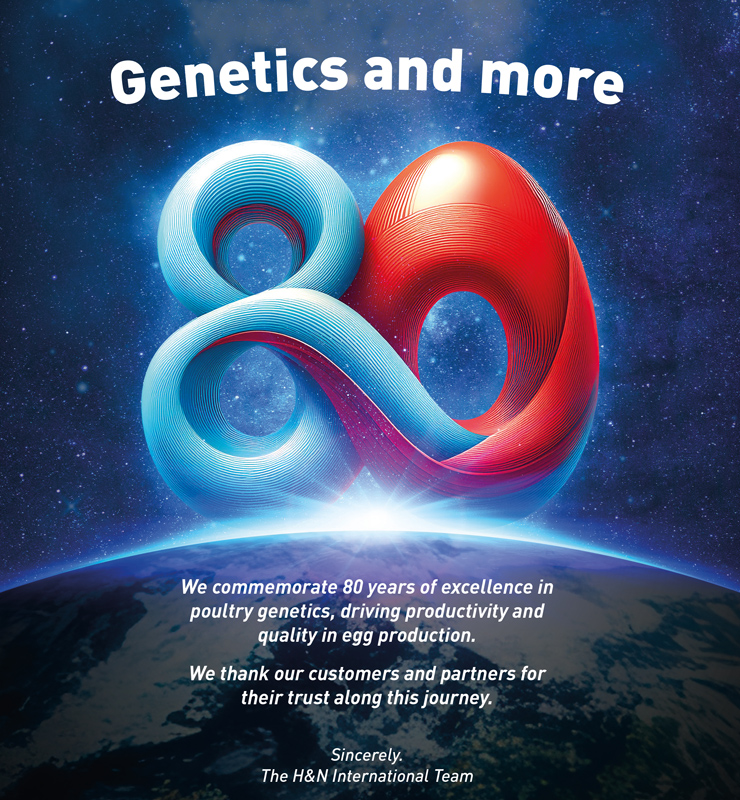In this article, we would like to present some of our most important egg quality measurements. In the breeding program of all H&N layers, the traits egg shell stability, egg-shell colour, albumen height, blood and meat spots and of course, egg weight are recorded repeatedly. There are many well-known breaking strength devices in the
market. In the routine recording of shell strength in the research farm, the results of one breaking strength device is usually combined with information about the dynamic stiffness from the “Crack Detector” to improve egg shell stability.
However, H&N has more testing methods available which are used for research projects to keep these opportunities for potential improvement in mind as well.
The GUTSCH breaking strength device was used for many years as the most favourable at H&N. It is simple to use, easily portable to farms, robust and delivers reliable data. Unfortunately, it does not only look “old-fashioned” but also the software and data transfer have become obsolete and are no longer compatible with new computer technologies.
The TSS breaking strength device has its advantages in an enhanced test throughput and revised software unlike the GUTSCH device, which is no longer manufactured. However, this breaking strength device needs a fixed workstation and is therefore located in our egg quality lab.
The FUTURA breaking strength device is new in our shell stability measurement collection. It is optimally adjusted to our breeding requirements. Each individual egg can be tested in a much quicker way than with other devices. Thanks to modern software, the required egg identification process is now easier to handle.
For nearly ten years now, the single Crack Detector is being used to improve dynamic eggshell stability on a genetic basis. The machine uses the same physical principles as large commercial egg graders which sort out eggs with hairline cracks and other defects. Heritability estimates are almost higher than for breaking strength and genetic correlations to each other are positive.
The single Crack Detector gives us additional information to improve the intense strength of egg resistance and has therefore been integrated into the selection index. Currently, shell thickness is not being routinely measured for all H&N breeds as the correlation to percentage of cracked eggs is lower as compared to breaking strength. We are, however, measuring shell thickness with a digital micrometer in different regions for egg quality research purposes. Measurement in the equatorial region is preferred where thickness is more uniform than in pole regions. To withstand the stress of handling from point of lay to the consumer, eggs should have a uniform shell thickness of about 0.35-0.40 mm. A new method of measurement available in the market is an ultrasound device which also measures the thickness of the egg shell. In order to verify the claimed thickness values of the manufacturer, H&N bought one of these devices. Analysis of repeated measurements for the same egg show low repeatability for egg shell thickness measured by ultrasound which highly restricts the suitability as a selection criteria in the breeding program.

The basis of our selection on egg weight is the mean value of three consecutive eggs from the same hen. To guarantee a flat shape of the egg weight curve as the hen grows older, egg weight is measured at different production stages. Negative relationships to other selection traits such as egg number or breaking strength have an influence on the decisions geneticists make during selection. However, modern breeding strategies simultaneously enable breeding progress in all traits.
Eggshell colour varies from chocolate brown to cream-coloured eggs which are laid by different lines. The preferred eggshell colour of our brown H&N breeds is an attractive dark brown colour which does not become paler at the end of production. Additionally, we are really keen on having high uniformity in eggshell colour for the Brown Nick pure lines.
From our perspective, the best method to test eggshell colour is the MINOLTA device. Minolta Chroma Meters are compact tristimulus colour analysers for measuring reflective colours of surfaces. It also enables to test shaped and round samples with good repeatabilities.
Crack Detector Shell thickness – micrometerscrew Shell thickness – Ultrasound Egg weight Depending on egg white consistency, albumen height varies mainly in storage conditions. Therefore, it is very important to test the eggs of pedigree birds not when they are fresh, but after a defined period of storage.
Differences in albumen height which are based on varying egg weights, are corrected in Haugh unit calculations. Haugh units are therefore more comparable when talking about the freshness of an egg. Heritability estimates for egg white consistency are on a medium level and therefore allow improvement through genetic selection.
Blood and meat spots are highly correlated with eggshell colour and are therefore frequently found in brown-shelled eggs as in white eggs. Precise screening of white eggs enable a rejection before consumers are bothered by blood and meat spots in their fried egg. For breeding reasons, brown eggs have to be broken to score each single egg. This is very labour-intensive and heritabilities are moderate. The success on this trait by breeding should therefore not be overestimated.
Capturing egg quality data and incorporating these traits into selection decisions have for a long time now, been one of the core criterions in the H&N breeding programme.
High productivity of the white and brown layers of H&N and also the necessity to meet the egg consumers demand for good internal and external egg quality shall remain of the driving forces for the genetics of H&N.
Dr. Wiebke ICKEN, Dr. Matthias SCHMUTZ
H&N Research Geneticists
By Courtesy of H&N International

